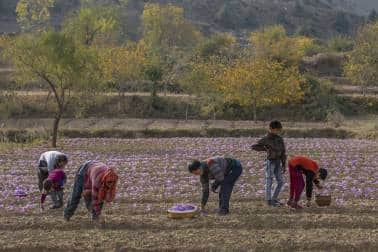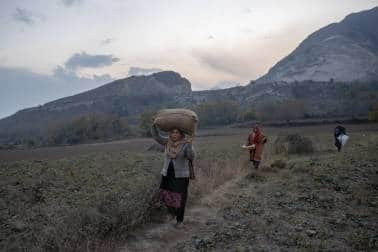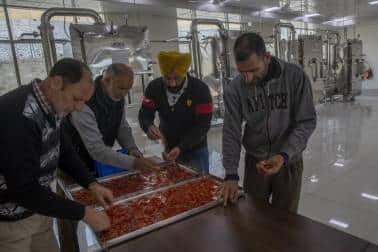



Saffron production in Kashmir peaked to highest in a decade, as the agriculture department recorded an annual yield of over 13 metric tonnes. The success is largely credited to the National Mission on Saffron - the union government scheme launched in 2010 with the target to increase saffron cultivation.
Kashmir Valley, along with parts of Iran and Spain, is among the handful of places in the world where saffron is grown. Known as the "world's most expensive spice", it sells at around Rs 1.5 lakh to Rs 2.5 lakh per kilogram.
 At the end of autumn, families in the Muslim-majority region race against the clock to harvest the saffron crocus flowers, which bloom for only two weeks a year. Men, women, and children stoop as they laboriously pick the delicate flowers and place them in wicker baskets. A Kashmiri farmer family plucks crocus flowers, the stigma of which produces saffron, on a farm in Khrew, south of Srinagar on Oct. 31, 2020. (AP Photo/Dar Yasin)
At the end of autumn, families in the Muslim-majority region race against the clock to harvest the saffron crocus flowers, which bloom for only two weeks a year. Men, women, and children stoop as they laboriously pick the delicate flowers and place them in wicker baskets. A Kashmiri farmer family plucks crocus flowers, the stigma of which produces saffron, on a farm in Khrew, south of Srinagar on Oct. 31, 2020. (AP Photo/Dar Yasin)
Saffron production had dipped to 1.489 metric tonnes in 2011, largely due to dry spells caused by lack of rainfall in September and October. A number of cultivators since the early 2000s had also begun converting their farmlands into apple orchards.
The Rs 410 crore National Mission on Saffron, launched in 2010, was aimed at rejuvenating the crop and introducing sprinkle irrigation. Under the scheme, 3,500 hectares of land where saffron is grown was covered.
The scheme led to an increase in per hectare production of saffron by 4.5 to 5 kilograms, Chief agriculture officer Mohammad Qasim Ghani said.
 In Kashmir, the spice is mostly used in Kehwa, a slow-brewed sugary green tea infused with spices like cinnamon and cardamom and garnished with almonds. Saffron is also used in Wazwan, a traditional Kashmiri wedding meal cooked by special chefs that includes more than 30 dishes. (Image: AP Photo)
In Kashmir, the spice is mostly used in Kehwa, a slow-brewed sugary green tea infused with spices like cinnamon and cardamom and garnished with almonds. Saffron is also used in Wazwan, a traditional Kashmiri wedding meal cooked by special chefs that includes more than 30 dishes. (Image: AP Photo)
"Kashmir has the potential to produce 6 to 7 kilograms of saffron per hectare. Earlier in the 1980s, our production was over 6 kilograms," Hindustan Times further quoted him as saying.
Jammu & Kashmir Lieutenant Governor Manoj Sinha also lauded the boost in saffron cultivation, calling it a "great achievement".
 In Kashmir, the spice is a source of pride and has fueled the region’s economy and culture for centuries. But over the years its cultivation has faced troubles due to climate change, poor irrigation facilities and imports of cheaper Iranian saffron.
In Kashmir, the spice is a source of pride and has fueled the region’s economy and culture for centuries. But over the years its cultivation has faced troubles due to climate change, poor irrigation facilities and imports of cheaper Iranian saffron.
"Annual yield of the world’s costliest spice, #Saffron, cultivated in Kashmir has crossed 13 metric tonnes for the first time in the last 10 years (sic)," the LG's Office tweeted.
Great Achievement: Annual yield of the world’s costliest spice, #Saffron, cultivated in Kashmir has crossed 13 metric tonnes for the first time in the last 10 years.@diprjk pic.twitter.com/CVHzeNJB4V— Office of LG J&K (@OfficeOfLGJandK) January 20, 2021
The bulk of Kashmir's saffron is grown in Pampore, based in South Kashmir. Out of the nearly 3,700 hectares of land where saffron is grown, around 3,200 hectares are based in Pampore. The remaining saffron farms are found on the outskirts of Srinagar and Budgam.
Discover the latest Business News, Sensex, and Nifty updates. Obtain Personal Finance insights, tax queries, and expert opinions on Moneycontrol or download the Moneycontrol App to stay updated!
Find the best of Al News in one place, specially curated for you every weekend.
Stay on top of the latest tech trends and biggest startup news.